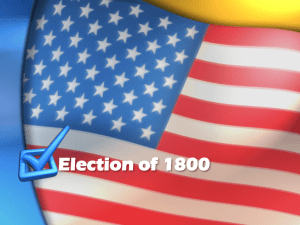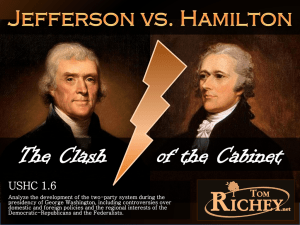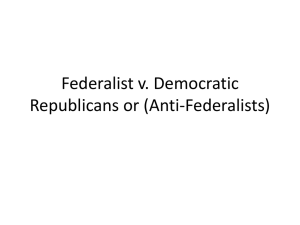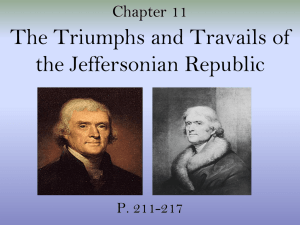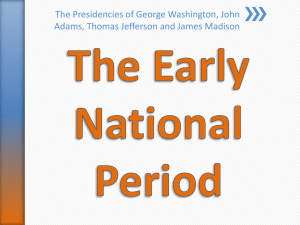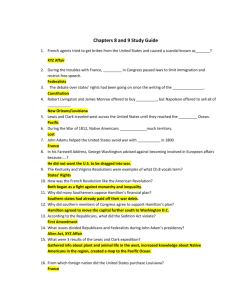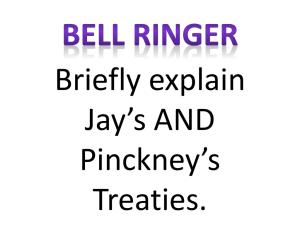Thomas Jefferson Elected President (better title: Election of 1800)
advertisement
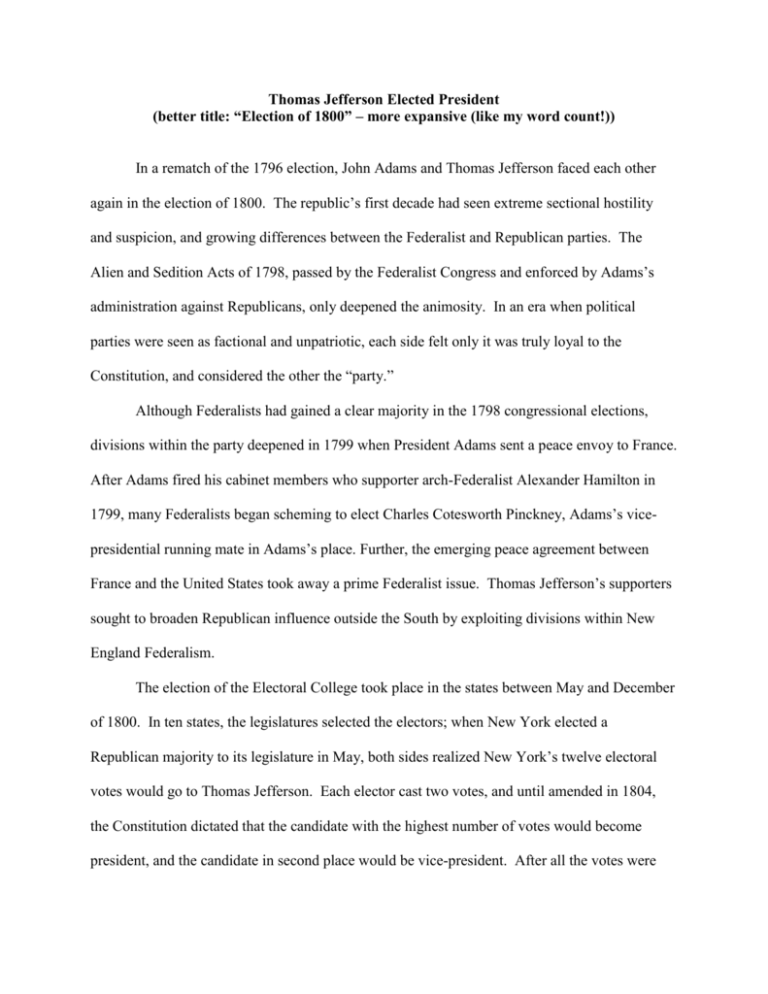
Thomas Jefferson Elected President (better title: “Election of 1800” – more expansive (like my word count!)) In a rematch of the 1796 election, John Adams and Thomas Jefferson faced each other again in the election of 1800. The republic’s first decade had seen extreme sectional hostility and suspicion, and growing differences between the Federalist and Republican parties. The Alien and Sedition Acts of 1798, passed by the Federalist Congress and enforced by Adams’s administration against Republicans, only deepened the animosity. In an era when political parties were seen as factional and unpatriotic, each side felt only it was truly loyal to the Constitution, and considered the other the “party.” Although Federalists had gained a clear majority in the 1798 congressional elections, divisions within the party deepened in 1799 when President Adams sent a peace envoy to France. After Adams fired his cabinet members who supporter arch-Federalist Alexander Hamilton in 1799, many Federalists began scheming to elect Charles Cotesworth Pinckney, Adams’s vicepresidential running mate in Adams’s place. Further, the emerging peace agreement between France and the United States took away a prime Federalist issue. Thomas Jefferson’s supporters sought to broaden Republican influence outside the South by exploiting divisions within New England Federalism. The election of the Electoral College took place in the states between May and December of 1800. In ten states, the legislatures selected the electors; when New York elected a Republican majority to its legislature in May, both sides realized New York’s twelve electoral votes would go to Thomas Jefferson. Each elector cast two votes, and until amended in 1804, the Constitution dictated that the candidate with the highest number of votes would become president, and the candidate in second place would be vice-president. After all the votes were finally tallied in late December, Jefferson and his vice-presidential running mate Aaron Burr had tied at 73 votes, Adams took 64, Pinckney 64, and John Jay 1. Adams carried 100% of the New England vote, while Jefferson claimed 85% of the South’s total. Pennsylvania and Maryland divided their votes nearly evenly between the two, and New York gave all to Jefferson. To break the tie between Jefferson and his running mate, the Constitution provided that in the event of a tie or failure to achieve a majority of electoral votes, the House of Representatives would make the choice. Each state cast one ballot, and the winning candidate had to carry nine of the sixteen states. Many Federalists decided to support Burr, reasoning that he would was not so “Republican” as Jefferson. Rumors circulated that some Federalists were plotting to delay the House vote altogether, leaving the country with no president in March 1801. Many people feared civil war was imminent, and the governors of Pennsylvania and Virginia prepared for a military confrontation. Hoping to avoid complete anarchy, the House voted to remain in session until the president was chosen, and began balloting on February 11, 1801. On the first ballot Jefferson won 8, Burr 6, with division in the Maryland and Vermont delegations canceling their votes. From 1 p.m. February 11 until 8 a.m. the next day twenty-seven ballots were cast, with no change. As rumors of civic unrest and armed conflict increased, Republicans asserted that Jefferson was the rightful winner; to preserve the union and the rule of constitutional law, Federalists acquiesced. Federalists from Vermont and Maryland left the chamber, allowing their Republican colleagues to cast their states’ votes for Jefferson, and Delaware and Maryland voted blank. Jefferson thus defeated Burr 10 to 4 on the 36th ballot, after six days of balloting. One of the nation’s most critical presidential elections, Republicans saw it as a triumph over Federalist tyranny, saving the American Revolution and republican government. It marked the first time power was transferred to an opponent in American politics. Republicans felt vindicated, that they had proved the Federalists illegitimate. Like the Federalists, they made no allowance for loyal opposition. In his inaugural address Jefferson asserted that we “are all republicans; we are federalists.” His remark sought reconciliation after the bitter partisan conflict, but also confirmed that no legitimate partisan division could exist. Jefferson, like the Federalists before him, equated loyalty to the country with loyalty to the president. Combined with sweeping Republican victories in congressional elections, the election of 1800 ended Federalist dominance in the federal government. Jefferson saw it not as a victory of Republicans over Federalists, however—the “Revolution of 1800” in his eyes was the triumph of the American people over a tyrannical faction. The culminating event American republic’s first decade, Jefferson’s election did not however close the door on partisan divisions and sectional hostility. Sources/Further Reading: James Roger Sharp. American Politics in the Early Republic: The New Nation in Crisis, pp. 226288. New Haven: Yale University Press, 1993. Stanley Elkins and Eric McKitrick. The Age of Federalism, 726-754. New York: Oxford University Press, 1993.
